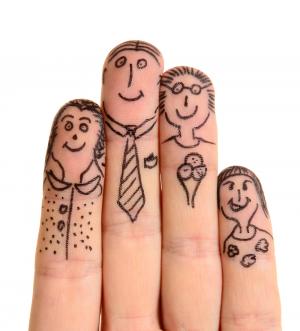June 28, 2014: I suppose gender issues have been on my mind days since forever, though not quite in the sense of immediacy as now.
 We all believe that Sikh teaching is so egalitarian and absolutely devoid of gender bias of any sort. Yet, we also know that our cultural practices and interpretations are so rife with gender issues that an outsider may wonder if we are even part of this modern world. Or are we in a schizoid reality.
We all believe that Sikh teaching is so egalitarian and absolutely devoid of gender bias of any sort. Yet, we also know that our cultural practices and interpretations are so rife with gender issues that an outsider may wonder if we are even part of this modern world. Or are we in a schizoid reality.
For example, I have heard respected Sikh scholars opine that the initiation into the Khalsa tradition was not open to women. It is said that the name "Singh" might have been endowed upon men initiates, but a distinctive name "Kaur" was not given to Sikh women at that time in 1699, because no women took amrit and formally became khalsa.
Forget for a moment that the assertion flies against all interpretations of the egalitarian teachings of gender equity by/of the Gurus. To have preached one thing for over two centuries, and then capped the whole movement by a practice that stood the message on its head - how credible, sensible or possible would that be?
What is often most discouraging is the obvious disconnect between Sikh teaching and Sikh practice, in many ways, between our head and the heart.
But are we so unique in that? And, even if we are much like many others, what does it mean to us?
Let me stir the pot a little more vigorously by jumping in with both feet!
I notice that some churches (mind you some, not all) require a certain number of men be present before the gathering can be recognized as a properly constituted congregation; I know because I was once invited to stand in, even though I was just a visitor and clearly not a Christian, because the number of men was one short of the minimum requirement. And there were plenty of Christian women around, but they were ignored - they didn't qualify.
In Orthodox Jews it takes ten men to form a minion, nine men and a woman would not do. On the other hand, Conservative and Reform Jews have women Rabbis.
Make no mistake, women are not unimportant to Judaism: the child of a Jewish mother is automatically accepted as a Jew, irrespective of the father's faith - it is a privilege not automatically available to the child of a Jewish father and a non-Jewish mother.
In the Roman Catholic Church, women may become nuns but not priests or enjoy priestly privileges; they may distribute the host at Communion, but not consecrate it. Many other Christian denominations are not so self-limiting.
In Islam, I have never seen a woman imam in public space.
The Hindu position is somewhat unclear. Most Hindu sects do not have women serving as clergy; in fact, the Hindu code-giver, Manu, decreed that women were not to be allowed access to religious scriptures. Yet, vestal virgins and dancing girls in Hindu temples were found aplenty at one time, nor are they absolutely extinct now. Yet, some Hindu sects do have women who serve as leaders and clergy in temples.
Why is it that in so many of the major religions of the world, including Sikhism, the public role of women has often been so diminished, even while they clearly recognized her importance in the rearing of children of faith?
If a problem is found pretty much universally, and is associated with most of the major religions, perhaps we should look for an explanation, not so much in religious doctrines or even in the fragile egos of men, but in the universal constraints of human societies that transcend geographical and cultural boundaries, and end up compromising the most dearly and rigidly held beliefs.
Most secular societies, too, are not free of gender bias; for instance, women in the United States won the right to vote only in 1920 after a protracted struggle. And even today in the 21st century we are still debating whether a woman can be elected president. And in the corporate world today women of equal qualifications earn about 30 percent less than their male counterparts.
(Keep in mind, dear reader, that I am only exploring possible explanations, not finding justifications for our less than perfect lives and cogitations.)
I offer you first the undeniable fact that until very recently in human history, men and women led essentially segregated lives; the essential determinative constraints for this were biological and economic.
Since the biologically more muscular men were the hunter-gatherers, and women were saddled with birthing children and nursing them, society essentially and largely became male-dominated, and gender-centered. Yet there exist some very successful matriarchal communities as well.
Historically, across the cultural spectrum, except for a very few enclaves, upon marrying a woman moved into the joint family structure of the husband. Perhaps it stemmed from the perceived need to preserve the family land holdings as undivided in primarily agricultural societies. But, it naturally led to the tacit assumption that the woman would adopt the religion and lifestyle of the husband and his family.
The remnants of such assumptions can be clearly seen even today, when upon marriage the woman adopts the last name of the husband, or when in most church weddings, the father of the bride symbolically hands his daughter to the groom. I know that exceptions to this are now increasingly more common, but they are still few and, even more importantly, are of recent vintage.
Most communities saw that for mothers the primary concern had to be children. They also recognized that cultural and familial values would be transmitted largely through the mothers, not by their oft-absentee fathers. Women, therefore, deserved more leeway.
Could women always be there at the beginning of the religious service? Would they have the time to spend in learning the rites and rituals, or parsing the meaning of doctrine? Unfortunately, the answer to both questions would have to be "likely not or certainly less than men."
In 1699, how was it that the first five Sikhs who responded to the call for a head were males? Why didn't women seem to heed the call of Guru Gobind Singh for a head? This can be simply handled but is usually not. Perhaps they were busy with their squabbling children who were climbing all over them. Perhaps they never even heard the call -- there were no public address systems and amplifiers then. Also, history tells us that about 80,000 people attended the event staged by Guru Gobind Singh. These hordes had to be fed; the langar kitchen might have claimed the attention and energy of women.
Also, I remind you that the cultural values of the times assumed that women (and families) would automatically follow the religious path that their men chose.
Yet, we know that many women must have imbibed the values of the Khalsa very well, at times, even better than the men had. When 40 Sikhs deserted Guru Gobind Singh, they were shamed into returning by a woman, and she - Bhag Kaur, popularly known as Mai Bhago - led them back into battle. To lead and to command these men, she must have been a strategic planner, proficient horsewoman, an expert with weapons of war, and with command presence.
Only then would battle hardened men have willingly, even admiringly, followed her into battle against heavy odds where every one of them became a martyr. Could she have possibly learned these skills in a day or a week? Hardly! Would men have followed her if she was not competent enough to earn their respect? Likely not!
But women like Bhag Kaur, Rani Jindan, and countless others were products of a certain time and culture in which their identity - even religious -- was derived from that of their husbands and families.. So, the civil or religious codes of society did not see any necessity to mention the role or position of women specifically and separately, except rarely. In a sense then these women were outliers and lamplighters.
My purpose in developing this argument, and very briefly providing a summary of what we find in some non-Sikh societies across time, culture and religion, is not to highlight our virtues or their shortcomings.
It is to suggest that our (Sikh) false starts and contradictions in gender issues are not unique to us. Undeniably though, we have effectively sidelined the women, and they are no longer central to our religious practices. We have in fact written women out of our history and our lives. But this is something that can and must be fixed by us.
Times have changed; our awareness has grown. We need not flagellate ourselves for our past, but we do need to change our mindset and our institutions. And we will surely find that our Gurus left us an egalitarian message devoid of any gender bias, whether in our homes, businesses or our religious institutions.
Reality now is different; the roles that men and women play in society are more equitable. Their skills are comparable, as are their rewards. Religions, too, need to reinterpret and refresh their language and practice to capture these changes. There is no dictum from God or Guru to prevent us from doing so. But we seem caught in a culture trap and a time warp. I'll spare my readers a lecture on the lines from gurbani that remind us of the equal place that women deserve in society.
So, when many religions adopted their coda, the intent might not have been to leave the women out, but the result inevitably was.
Now the onus is on us.
I.J. Singh
